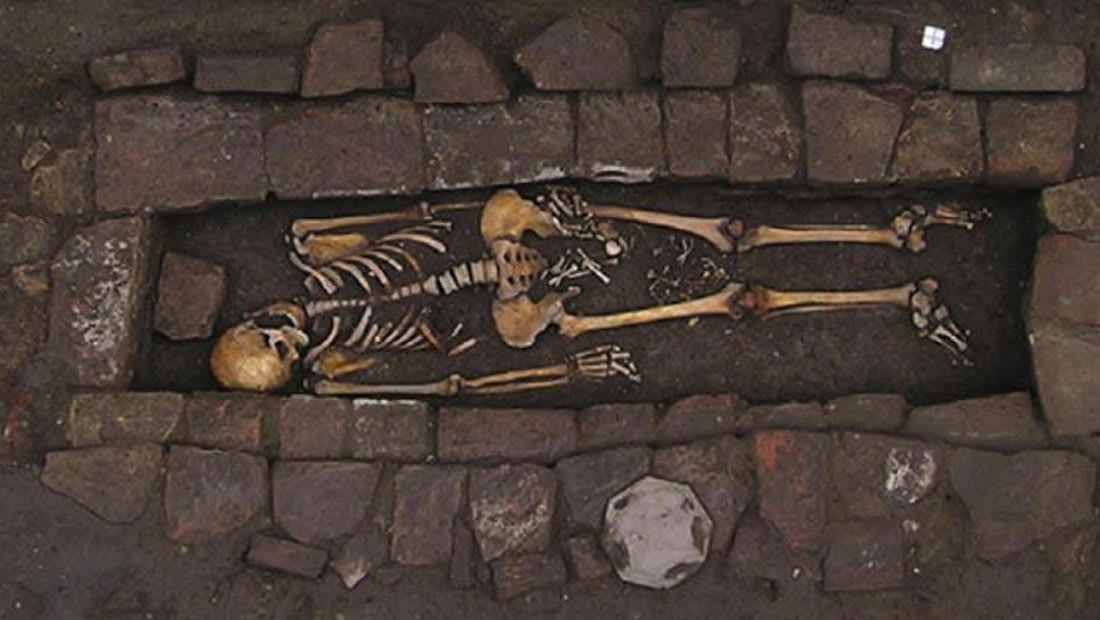دبي، الإمارات العربية المتحدة (CNN) -- تفاجأ باحثون عند فتح تابوتٍ لامرأة شابة يعود إلى القرون الوسطى في إيطاليا بعد اكتشافه عام 2010، بوجود ثقبٍ مثالي في عظمها الجبهي، وسلسلة من عظامٍ صغيرة بين ساقيها تعود إلى طفل.
والسبب من وراء الثقب يعود إلى عمليةٍ خضعت لها المرأة قبل أسبوعٍ من وفاتها خلال العصر اللومباردي في إيطاليا بين القرنين السابع والثامن، وهو نوعٍ من جراحة الأعصاب يتم فيها حفر أو كشط ثقبٍ في العظم، ويُعرف بـ"نقب الجمجمة."
ورغم أن المرأة كانت في الأسبوع الثامن والثلاثين من الحمل، إلا أنها لم تتح لها فرصة إنجاب طفلها، وبدلاً من ذلك، وُضع الطفل في حالة "ولادة في النعش"، وخرج فيها الجنين بعد وفاته بسبب ضغط الغاز المتزايد في جسم الأم وعوامل التحلّل.
وهذه هي المرة الأولى التي يُعثر فيها على حالةٍ لنقب الجمجمة وولادة في النعش في الوقت ذاته.
وقام باحثون من جامعة فيرارا بوصف هذا الاكتشاف النادر في مجلة “جراحة المخ والأعصاب في العالم". ولم يُعرف السبب وراء خضوع المرأة لعملية نقب الجمجمة، ولكن يرجح الباحثون أنها كانت محاولةً لإنقاذ حياتها لتتمكن من ولادة طفلها.
وآنذاك، كانت هذه العملية تستخدم في علاج الإصابات العصبية أو الصداع النصفي. ويرجح استخدام العملية أيضاً في علاج مقدمات الارتعاج، أي اضطراب ضغط الدم الناجم عن الحمل.
وأكدت المؤلفة المشاركة والباحثة في مختبر الأنثروبولوجيا الطبية الشرعية في جامعة فيرارا، ألبا باسيني، على أهمية هذا الاكتشاف قائلةً إن "هذه الحالة مهمة لأنها تؤكد وجود نهجٍ طبي لوفيات الأمومة خلال العصر اللومباردي، بالرغم من رفض التقدم العلمي آنذاك، وهو ما ميّز فترة العصور الوسطى المبكرة برمتها."
وأضافت باسيني: "أيضاً، تبين (الحالة) اكتشافين نادرين، بسبب ندرة الولادة في النعش (خصوصاً في العينات الأثرية)، وذلك في حين وجود أمثلة قليلة من عمليات نقب الجمجمة في العصور الوسطى المبكرة في أوروبا."
وحلل الباحثون منطقة الثقب في جمجمة المرأة وكشفوا أنها عاشت لمدة أسبوعٍ فقط بعد خضوعها للعملية.
وقالت باسيني: "كان الحمل في مرحلةٍ متأخرة، وكاد يصل إلى موعد الولادة. ولكننا لا يمكننا جزم إذا كانت هناك إمكانيةٌ لإنقاذ الجنين لأننا لا نعرف بالتحديد المرض المحدد الذي عانت منه المرأة،" لافتة إلى غرابة حالة نقب الجمجمة والولادة في النعش، إذ برأيها يمثل العثور عليهما في الشخص ذاته حدثاً مميزاً حقاً.

